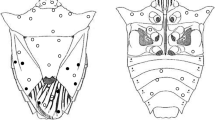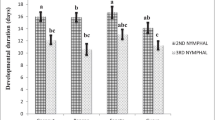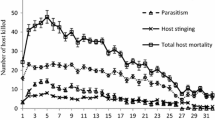Abstract
Observations on the biology ofCheiropachus quadrum (Hym: Pteromalidae) andDendrosoter protuberans (Hym: Braconidae), were conducted. Both species are the main parasites of the olive bark beetlesHylesinus varius andPhloeotribus scarabaeoides (Col: Scolytidae) in the South of Spain. Results have shown that an increase in body size of the host does not imply an increase in parasite efficiency. In fact, host size inversely affects parasite efficiency forC. quadrum. Bearing in mind this fact, the abundance of the host and the ease of its rearing in the lab, it is therefore advisable to useP. scarabaeoides as the host for mass rearing of the parasites studied here. On the other hand, the presence of white light is a negative factor for parasite longevity and fecundity. The pupae and all larval instars are parasitised.C. quadrum does not have a preference for any particular stage or larval instar of the host whilst there is a preference for the third and fifth larval instar byD. protuberans. With respect to the sex ratio of parasites, an increase in the number of males increases the fecundity of the females. The results obtained in this study can be considered essential in the development of a biological control system for olive bark beetle pests based on an increase in the population ofC. quadrum andD. protuberans.
Résumé
Des observations ont été réalisées sur la biologie deCheiropachus quadrum F. (Hym.: Pteromalidae) etDendrosoter protuberans (Nees) (Hym.: Braconidae), principales espèces de parasitoïdes des scolytes ravageurs de l'olivier,Hylesinus varius F. etPhloeotribus scarabaeoides (Col.: Scolytidae), dans le sud de l'Espagne. Les résultats ont montré qu'une augmentation de la taille du corps de l'hôte n'implique pas une augmentation de l'efficacité parasitaire. En fait, la taille de l'hôte agit sur l'efficacité parasitaire d'une façon inverse pourC. quadrum. D'après cette observation et vu l'abondance de l'hôte et la facilité de son élevage en laboratoire, il est donc conseillé d'utiliserP. scarabaeoides comme hôte pour l'élevage de masse des parasitoïdes étudiés ici. Par ailleurs, la lumière blanche est un facteur négatif en ce qui concerne la longévité et la fécondité du parasitoïde. Le stade pupe ainsi que tous les stades larvaires sont parasités.C. quadrum ne montre aucune préférence pour un stade de développement particulier de l'hôte alors que chezD. protuberans, il y a une préférence pour le 3e et le 5e stade larvaire. Quant à la sex ratio des parasitoïdes, une augmentation du nombre de mâles augmente la fécondité des femelles. Les résultats obtenus par cette étude sont très importants et vont permettre le développement d'un programme de lutte biologique contre les scolytes de l'olivier basé sur l'accroissement des populations deC. quadrum etD. protuberans.
Similar content being viewed by others
References
Arambourg, Y. — 1975. Insectes nuisibles à l'olivier.II Sem. Oleicola International. — Córdoba (España).
Beaver, R. A. — 1966. The development and expression of population tables for the bark beetleScolytus scolytus (F.). —J. Anim. Ecol., 35, 27–41.
Campos, M. &González, R. — 1990. Influence of breeding conditions on longevity and fecundity ofRaphitelus maculatus (Hym: Pteromalidae) reared under standard laboratory conditions.Entomophaga, — 35, 411–420.
Dominguez García-Tejero, F. — 1989. Plagas y enfermedades de las plantas cultivadas. —Ed. Mundi Prensa, 821 pp.
González, R. &Campos, M. — 1990a. Cría en laboratorio dePhloeotribus scarabaeoides (Bernard, 1788). —Bol. San. Veg. Plagas, 16, 355–361.
González, R. &Campos, M. — 1990b. Rearing ofCheiropachus quadrum (Hym: Pteromalidae) from the olive bark beetlePhloeotribus scarabaeoides (Col: Scolytidae). Potential biological control agent. —Redia, 73, 495–505.
González, R. &Campos, M. — 1991. Effect of parent density on fecundity of two parasitoids (Hym: Pteromalidae) of the olive beetle,Phloeotribus scarabaeoides (Col: Scolytidae). —Entomophaga, 36, 473–480.
Kudon, L. H. &Berisford, C. W. — 1980. Influence of brood hosts on host preferences of bark beetle parasites. —Nature, 283, 288–290.
Lozano, C. — 1993. Estudio Bio-ecológico deHylesinus varius (Fabricius, 1775) (Col; Scolytidae) en la provincia de Granada. Tesis Doctoral. Universidad de Granada, 216 p.
Lozano, C. &Campos, M. — 1991. Preliminary study of the entomofauna of the bark beetle,Leperisinus varius (Coleoptera: Scolytidae). —Redia, 74, 241–243.
Lozano, C. &Campos, M. — 1993. Laboratory-rearing ofHylesinus varius (Col: Scolytidae). —Bull. Soc. Ent. Suisse, 66, 317–322.
Lozano, C., Kidd, N. A. C. &Campos, M. — 1993. Studies on the population dynamics of the bark beetleLeperisinus varius (Fabr.) (Col: Scolytidae) on european olive (Olea europaea). —J. Appl. Ent., 116, 118–126.
Mendel, Z. — 1986. Hymenopterous parasitoids of the bark beetles (Scolytidae) in Israel: Relationship between host and parasitoid size and sex ratio. —Entomophaga, 31, 127–139.
Mills, N. J., Krüger, K. &Schlup, J. — 1991. Short-range host location mechanisms of bark beetle parasitoids. —J. Appl. Ent., 111, 33–43.
Schröder, D. — 1974. Untersuchungen über die aussichten einer biologischen bekämpfung von scolytiden an ulmen als mittel zur einschränkung des ulmensterbens. —Z. Angew. Ent., 76, 150–159.
Author information
Authors and Affiliations
Rights and permissions
About this article
Cite this article
Campos, M., Lozano, C. Observations on the reproductive biology of two parasites ofHylesinus varius andPhloeotribus scarabaeoides (Col: Scolytidae): Cheiropachus quadrum (Hym: Pteromalidae) andDendrosoter protuberans (Hym: Braconidae) . Entomophaga 39, 51–59 (1994). https://doi.org/10.1007/BF02373494
Received:
Accepted:
Issue Date:
DOI: https://doi.org/10.1007/BF02373494




